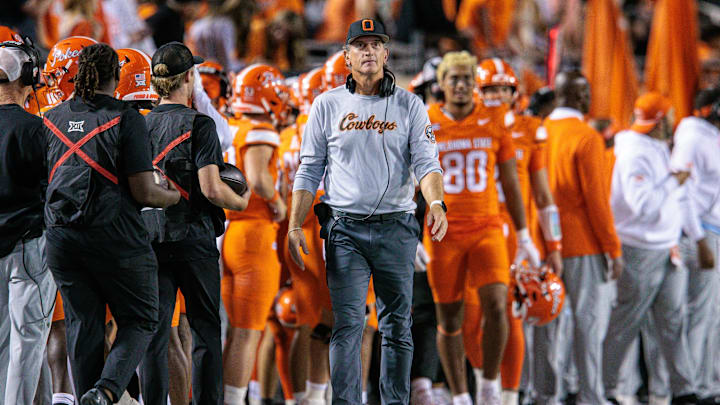At the start of this college football coaching cycle, the Oklahoma State job looked like one of the more appealing options on the board. When the list of available Power 4 positions included Virginia Tech, UCLA, Arkansas, and Oklahoma State, the Cowboys were right in the mix, seen as a potential destination for an up-and-coming coach or a veteran looking for a rebound. But as the carousel continues to spin, with more high-profile openings emerging, most notably at Penn State and Florida, the Oklahoma State job is beginning to slide down the rankings.
Each time a job with more brand power or better access to resources becomes available, Oklahoma State’s status drops another notch. What was once considered a top-tier opening this offseason is now firmly in the second tier, potentially even at risk of falling further depending on how the market shakes out in the coming weeks. The perception shift is being driven by a mix of recent on-field struggles, questions about long-term competitiveness in the Big 12, and a crowded coaching market that now includes major SEC and Big Ten programs.
Recent Performance and the CFP Hurdle
On-field success has historically been one of Oklahoma State’s strengths. Under Mike Gundy, the Cowboys had a long run of winning seasons, several 10-win years, and regular appearances in the national conversation. But the last two seasons have seen a sharp decline, possibly one of the worst stretches in recent program history. That recent downturn has undoubtedly hurt the job’s appeal, especially in comparison to programs that are either winning now or have a clearer path to a turnaround.
Another factor working against Oklahoma State is access to the College Football Playoff. As the Big 12 undergoes realignment and redefinition, its national clout is perceived as weaker than the SEC or Big Ten. Even with playoff expansion, teams from the Big 12 may have to go undefeated or win impressively just to earn consideration, making it a more difficult road than schools in more powerful conferences. While the right coach could navigate those hurdles, it makes the OSU job less attractive when compared side-by-side with others that offer a quicker or more respected playoff path.
Talent Access, Leadership, and Support
Recruiting at Oklahoma State isn’t impossible, the program sits in a reasonable location to pull talent from Texas and nearby states, but it requires the right leadership. With a good staff and clear identity, OSU can absolutely build competitive rosters. That said, in recent years the program has struggled to keep pace with its peers in both recruiting and the transfer portal. Whoever steps in next will need to reestablish the Cowboys’ identity and win key recruiting battles, both high school and portal-driven.
On the leadership front, there’s been progress. Athletic Director Chad Weiberg is now under contract for the foreseeable future, and there’s more stability in university leadership than there was during the initial stages of the coaching transition. That’s a crucial piece for any coach evaluating a job — knowing the administration is aligned and committed. However, financial support remains a gray area. Oklahoma State has potential access to significant donor backing, but the next hire may require a clear and upfront commitment from boosters that the resources will be there to compete, particularly in the era of NIL and facilities arms races.
The Stanford Job Is Quietly Gaining Ground
While Oklahoma State is slipping in the eyes of many, another program is starting to generate quiet buzz: Stanford. The Cardinal were widely expected to be bottom-dwellers this year, especially in the wake of conference realignment chaos and a depleted roster. But at 3–4 overall and 2–2 in conference play, Stanford has overachieved and earned a second look.
What makes Stanford intriguing isn’t just performance. It’s the long-term potential of the job. This is a program with a track record, under Jim Harbaugh and David Shaw, it was a consistent top-10 team, producing NFL talent and winning big games. Now, with Stanford alum and former NFL quarterback Andrew Luck stepping in as General Manager, the program has a leader who deeply understands both football and the school’s academic mission. His presence adds credibility and optimism to the rebuild, especially among candidates who value long-term institutional alignment.
The Coaching Market Is Crowded, and OSU Must Act Strategically
With the addition of Penn State and Florida to the market, top coaching candidates will naturally gravitate toward the biggest brands with the clearest path to national relevance. That forces Oklahoma State to shift its pitch. The Cowboys can’t compete with the Gators or Nittany Lions in terms of tradition, money, or exposure but they can offer opportunity. The right coach could turn OSU into a Big 12 contender again, especially with the conference’s new structure. But to do that, the school must be honest about where it stands and aggressive in making its next hire.
To stay relevant in this crowded landscape, Oklahoma State needs to be aligned from top to bottom. It must provide clarity to candidates that there will be resources, patience, and a real shot at building a winner. Without that, the Cowboys risk not only missing out on top candidates but potentially falling further behind programs that are already making moves.
